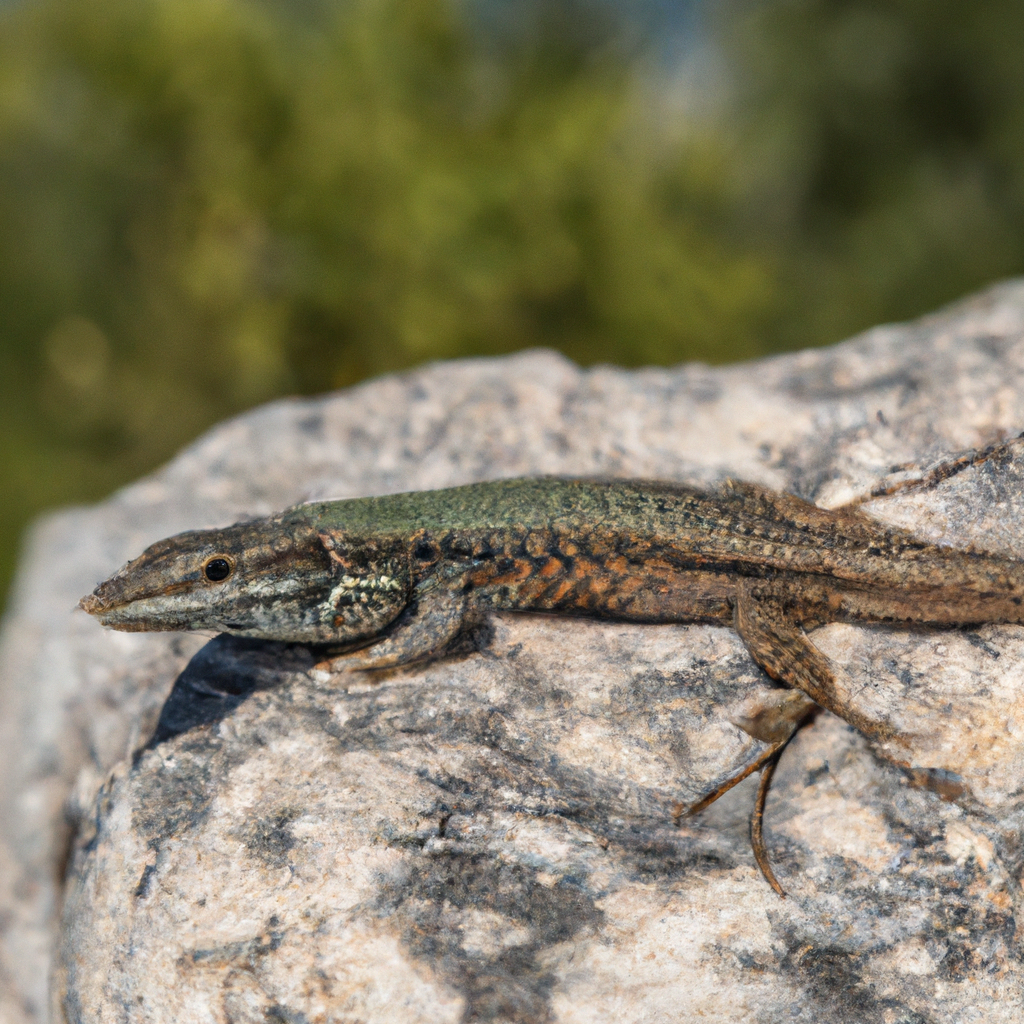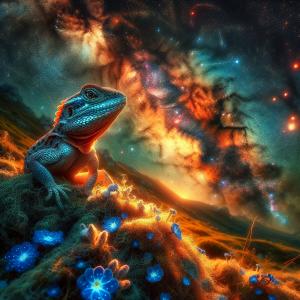Lizards in the Mediterranean Basin
Have you ever stopped to marvel at the diverse world of lizards that call the Mediterranean Basin their home? It’s truly a fascinating realm filled with unique reptilian wonders waiting to be discovered.
Did you know that the Mediterranean Basin is home to over 100 species of lizards? From the agile Common Wall Lizard to the striking Ocellated Lizard, each species has adapted in remarkable ways to thrive in this diverse region. These lizards come in a variety of shapes, sizes, and colors, making them a captivating subject for anyone interested in wildlife.
Exploring the world of lizards in the Mediterranean Basin opens up a realm of discovery and appreciation for the intricate ecosystems that support these creatures. As you delve deeper into their habitats and behaviors, you’ll find yourself amazed by their ability to survive and thrive in such diverse environments.
Whether you’re a seasoned lizard enthusiast or just starting to dip your toes into the world of herpetology, the Mediterranean Basin offers a rich tapestry of lizard species waiting to be explored. So next time you find yourself wandering through the sun-soaked landscapes of the Mediterranean, take a moment to appreciate the hidden world of lizards that surrounds you.
Join me on this journey of discovery as we uncover the secrets of these fascinating creatures and gain a deeper understanding of their vital role in the delicate balance of the Mediterranean Basin ecosystem. Let’s embark on this adventure together and unlock the wonders of lizards in this captivating region!
Importance of Lizards in the Ecosystem
Let me share an interesting fact about the importance of lizards in the ecosystem. Did you know that lizards play a crucial role in controlling insect populations in the Mediterranean Basin? It’s like having tiny pest controllers running around in nature!
Think about it – lizards are natural predators of insects like mosquitoes, flies, and beetles. By feeding on these insects, lizards help maintain a balance in the ecosystem. Without them, these insect populations could grow out of control, potentially causing disruptions to the food chain and ecosystem health.
Imagine a world without lizards keeping insect populations in check. We might be dealing with more mosquito bites during our outdoor adventures or seeing more crop damage from insect pests. So, next time you spot a lizard basking in the sun or darting across a rock, appreciate the important role they play in maintaining the natural balance of the Mediterranean Basin ecosystem.
This fact highlights the interconnectedness of species in the ecosystem and underscores the significance of even the smallest creatures in nature. It’s fascinating to think about how each organism, like the humble lizard, contributes to the overall health and functioning of the environment we all share.
So, the next time you see a lizard scurrying by, take a moment to appreciate its role as a natural pest controller in the Mediterranean Basin. Nature truly is full of amazing and essential interactions that keep our world in harmony.
Common Species of Lizards in the Mediterranean Basin
Did you know that the Mediterranean Basin is home to a diverse range of lizard species, each with its own unique characteristics? From the vibrant colors of the Ocellated Lizard to the impressive size of the Moorish Gecko, these lizards have adapted to thrive in the varied landscapes of the region.
Exploring the common species of lizards in the Mediterranean Basin is like embarking on a fascinating journey through the world of reptiles. Picture yourself in the warm Mediterranean sun, surrounded by rocky outcrops and lush vegetation, as you encounter these incredible creatures in their natural habitats.
One of the most well-known lizard species in the region is the Moorish Gecko, recognized for its large size and distinctive bumpy skin. These geckos are nocturnal hunters, using their sticky toe pads to climb walls and catch insects under the cover of darkness. Imagine stumbling upon one of these geckos during a moonlit stroll along a Mediterranean village – a magical sight to behold!
Another common lizard you might come across is the Turkish Gecko, known for its ability to change color based on its surroundings. These masterful camouflagers blend seamlessly into their environment, making them a challenge to spot even for the keenest of observers. Have you ever tried to locate a well-camouflaged lizard in the wild?
As you delve deeper into the world of lizards in the Mediterranean Basin, you’ll discover a multitude of species that showcase the region’s rich biodiversity. From the agile Snake-eyed Lizard to the elusive Tyrrhenian Wall Lizard, each lizard adds a unique touch to the tapestry of Mediterranean wildlife.
So, next time you find yourself in the Mediterranean Basin, keep an eye out for these enchanting creatures. Who knows what fascinating encounters await you as you venture into the realm of lizards in this captivating region!
Habitat and Distribution of Mediterranean Basin Lizards
In the Mediterranean Basin, the habitat and distribution of lizards are truly fascinating. These reptiles have adapted to thrive in diverse landscapes, from rocky cliffs to sandy beaches, making them a crucial part of the region’s ecosystem.
Imagine walking along the sunny coast of the Mediterranean and spotting a vibrant lizard darting across the rocks. It’s a sight to behold, showcasing how these creatures have evolved to inhabit such varied environments. The Mediterranean Basin provides an ideal setting for these lizards to flourish, with its warm climate and abundant food sources.
One interesting fact about the habitat and distribution of Mediterranean Basin lizards is that each species has its preferred type of environment. Some lizards, like the Ocellated Lizard, are commonly found in dry, rocky areas, while others, such as the Moorish Gecko, prefer more humid habitats near water sources. Understanding these habitat preferences is crucial for conservation efforts and ensuring the survival of these unique species.
The challenge lies in protecting these diverse habitats from human activities such as urbanization, agriculture, and tourism. As these landscapes face increasing pressures, it is essential to raise awareness about the importance of preserving these environments for the lizards and other wildlife that call them home.
To help conserve the habitat and distribution of Mediterranean Basin lizards, individuals can support local conservation initiatives, minimize their impact on natural areas, and educate others about the value of preserving these ecosystems. By taking small steps, we can contribute to the long-term survival of these fascinating reptiles and the biodiversity of the Mediterranean Basin as a whole.
So, next time you find yourself exploring the Mediterranean coastline, keep an eye out for these remarkable lizards and appreciate the unique habitats they inhabit. By understanding and protecting their environment, we can ensure that these creatures continue to thrive for generations to come.
Adaptations of Lizards to the Mediterranean Climate
You know, one fascinating thing about the lizards in the Mediterranean Basin is their incredible ability to adapt to the challenging climate of the region. These lizards have evolved some pretty cool strategies to thrive in the hot and arid conditions. For example, did you know that some species of lizards in the Mediterranean Basin have specialized scales that help reflect sunlight and regulate their body temperature? It’s like having built-in sunscreen and air conditioning!
These adaptations are crucial for their survival in such harsh environments. The Mediterranean climate can be scorching during the summer months, with limited water sources and intense heat. Yet, these resilient lizards have found ways to not only survive but also thrive in these conditions.
It’s truly amazing to think about how these creatures have evolved over time to conquer the challenges of their habitat. Observing these lizards in action, basking in the sun or darting across rocky terrain, can give you a newfound appreciation for the wonders of nature.
Next time you’re out exploring the Mediterranean Basin, keep an eye out for these remarkable lizards and take a moment to marvel at their unique adaptations. Who knows, you might just spot one of these incredible creatures showcasing their impressive survival skills right before your eyes!
Threats to Lizards in the Mediterranean Basin
You know, when it comes to the threats facing lizards in the Mediterranean Basin, it’s crucial to understand the various challenges they encounter. One practical tip I’d recommend is to raise awareness about habitat destruction and fragmentation. By spreading the word about the importance of preserving natural habitats for these fascinating creatures, we can contribute to their conservation.
It’s interesting to note that urbanization, agriculture, and climate change are major factors impacting the habitats of Mediterranean Basin lizards. These changes can lead to loss of suitable habitats, disruption of migration routes, and reduced prey availability, all of which can have detrimental effects on lizard populations.
By educating ourselves and others about these threats, we can take steps to minimize our impact on lizard habitats. Simple actions like supporting conservation organizations, participating in habitat restoration projects, and advocating for responsible land use can make a real difference in protecting these unique reptiles.
Next time you’re out exploring nature in the Mediterranean Basin, keep an eye out for signs of habitat degradation and think about how you can help mitigate these threats. Every small effort counts when it comes to safeguarding the future of these incredible lizards and preserving the biodiversity of this beautiful region.
Conservation Efforts for Mediterranean Basin Lizards
Picture this – a group of dedicated individuals, each with a passion for protecting the diverse wildlife of the Mediterranean Basin, coming together to save the lizards that call this region home. It’s like a real-life superhero team, but instead of capes, they wear boots and carry field guides!
The conservation efforts for Mediterranean Basin lizards are not just about saving a single species; they are about preserving a delicate balance in nature. By focusing on protecting these reptiles, we are also safeguarding the habitats they rely on and the intricate web of life that sustains them.
Think of it as a puzzle – each lizard species fits perfectly into its ecological niche, contributing to the overall health of the ecosystem. When one piece goes missing, the puzzle becomes incomplete, and the picture is not as vibrant as it once was.
The conservationists working tirelessly to protect these lizards are like puzzle masters, carefully placing each piece back where it belongs. They study the habitats, track populations, and implement strategies to ensure that these amazing creatures continue to thrive in their natural environment.
It’s a labor of love, driven by a deep respect for nature and a commitment to preserving the beauty and biodiversity of the Mediterranean Basin. So, the next time you see a lizard basking in the sun or darting across a rocky outcrop, take a moment to appreciate the intricate connections that sustain these fascinating creatures and the dedicated efforts to ensure their survival.
Tips for Observing Lizards in the Wild
Let me share a practical tip for observing lizards in the wild. When you’re out exploring the Mediterranean Basin, keep in mind that lizards are often found basking in the sun to regulate their body temperature. So, if you’re on the lookout for these fascinating creatures, be sure to scan sunny spots such as rocks, walls, and tree trunks where they like to soak up the warmth.
One thing I’ve learned from my own experiences is that patience is key when trying to spot lizards in their natural habitat. These agile creatures can blend in seamlessly with their surroundings, making them quite tricky to spot at times. So, take your time and move slowly, keeping your eyes peeled for any movement or rustling in the vegetation.
Another handy tip is to visit lizards’ favorite hangout spots during the warmer parts of the day when they are most active. Since lizards are ectothermic and rely on external sources of heat to regulate their body temperature, they are more likely to be out and about during sunny and warm weather.
To enhance your chances of spotting lizards, consider bringing along a pair of binoculars or a camera with a zoom lens to help you observe them from a distance without disturbing their natural behavior. Remember to respect their space and avoid approaching too closely, as this can cause unnecessary stress to these small reptiles.
By following these simple tips and being mindful of the lizards’ behaviors and habitats, you’ll increase your chances of having a rewarding and memorable experience observing these incredible creatures in the wild. So, grab your gear, head outdoors, and start your lizard-watching adventure in the beautiful Mediterranean Basin!
Interesting Facts about Lizards in the Mediterranean Basin
Let me tell you an interesting fact about lizards in the Mediterranean Basin! Did you know that some species of lizards in this region have the ability to detach their tails as a defense mechanism? It’s like having a built-in escape plan! When a predator tries to catch them, these lizards can voluntarily shed their tails, leaving the predator with just a wiggling distraction while the lizard makes a quick getaway.
This fascinating adaptation serves as a survival strategy for Mediterranean Basin lizards. The detached tail continues to wriggle, drawing the predator’s attention away from the lizard itself, giving it a chance to escape unharmed. The lost tail will eventually regenerate, although the new one may look slightly different from the original.
Imagine witnessing this incredible phenomenon in action while exploring the Mediterranean Basin! Observing such natural behaviors can provide a deeper appreciation for the unique adaptations that have evolved in these lizard species over time. It’s truly a marvel of nature’s ingenuity and resilience.
Next time you’re out exploring nature or hiking in the Mediterranean region, keep an eye out for these remarkable lizards and their tail-shedding abilities. It’s a reminder of the diverse and remarkable ways in which animals have adapted to survive in their environments. Nature never ceases to amaze us with its wonders!
So, if you ever spot a lizard in the Mediterranean Basin with a missing tail, don’t worry—it’s just one of nature’s clever tricks at play. Take a moment to appreciate the resilience and resourcefulness of these fascinating creatures that call the Mediterranean Basin their home.
Conclusion and Call to Action
Do you realize how essential lizards are to the delicate balance of the Mediterranean Basin ecosystem? It’s quite fascinating when you think about it. These seemingly small creatures play a vital role in maintaining the biodiversity of this region. By preying on insects and other small animals, lizards help control populations that could otherwise overrun the area.
Imagine a scenario where lizards were no longer around. The insect population could explode, leading to a cascading effect on plants and other animals in the ecosystem. This disruption could have far-reaching consequences, impacting not just the local environment but also the lives of people living in the Mediterranean Basin.
Moreover, studying lizards in this region provides valuable insights into the effects of climate change and habitat destruction. As temperatures rise and habitats are altered, the behavior and distribution of lizards are also changing. By monitoring these changes, scientists can better understand the broader implications of environmental shifts and the importance of conservation efforts.
So, the next time you come across a lizard basking in the sun or scurrying across a rock in the Mediterranean Basin, take a moment to appreciate the significance of these creatures. They are not just fascinating reptiles but also key players in maintaining the health and balance of the unique ecosystem in which they reside.




